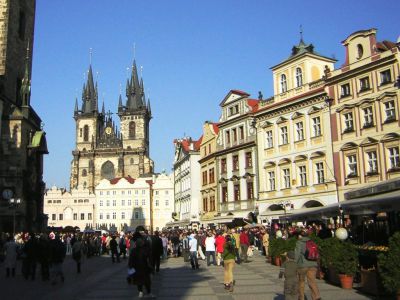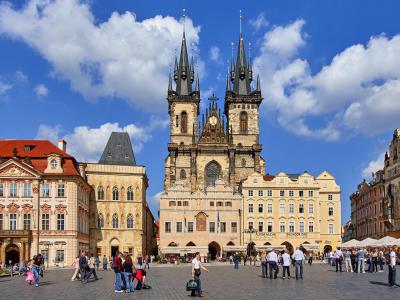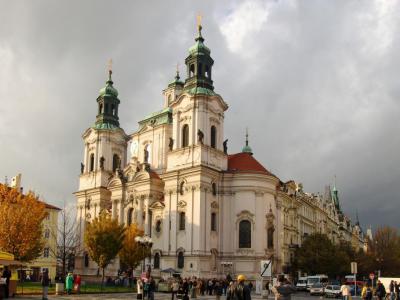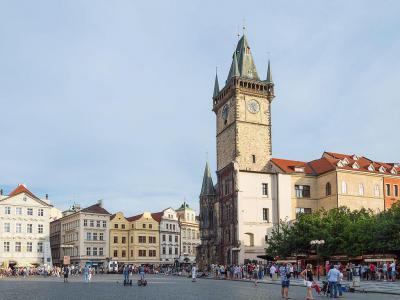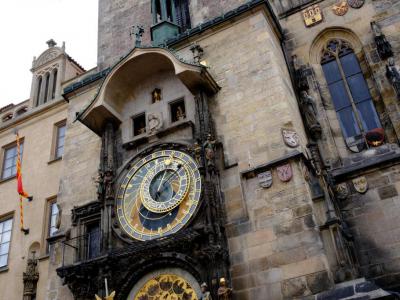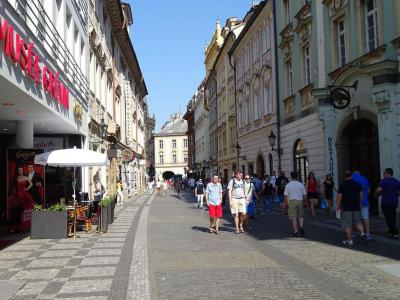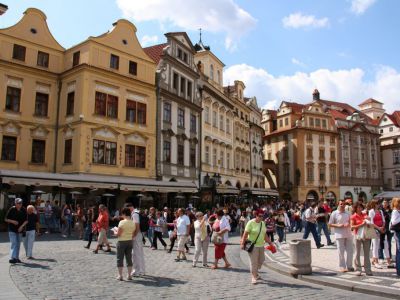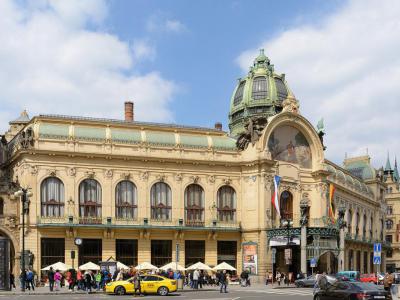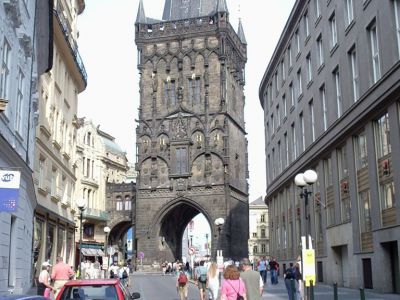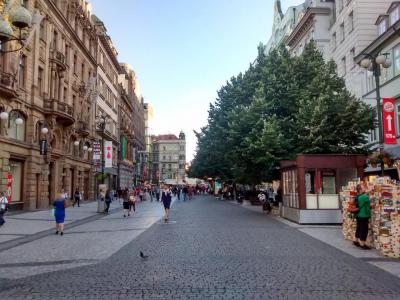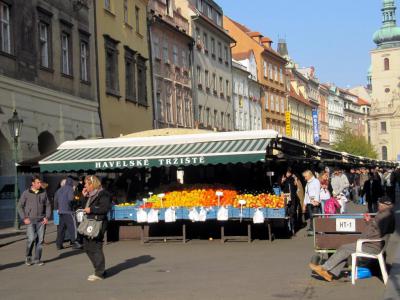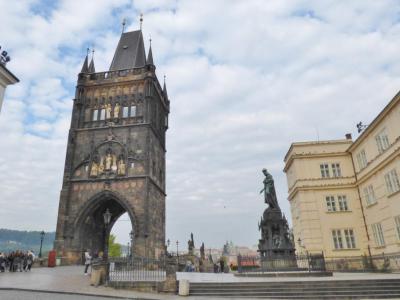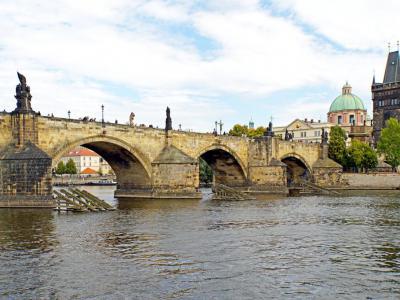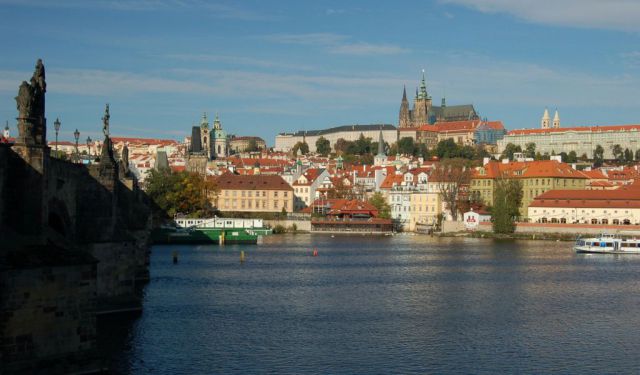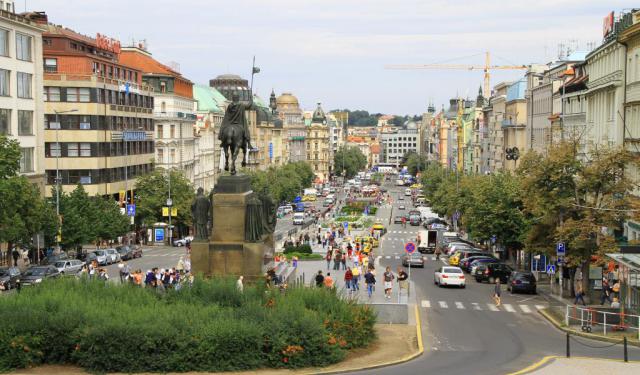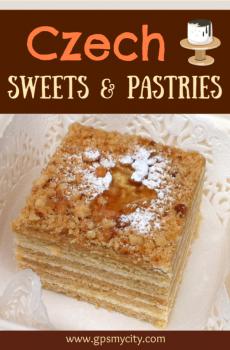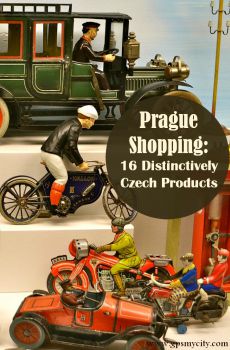Audio Guide: Old Town Walking Tour (Self Guided), Prague
Prague’s Old Town is a living tapestry of medieval roots and vibrant modern life, wrapped in narrow cobblestone streets and brimming with architectural treasures. Once a self-contained settlement, it was protected by a semi-circular moat and a fortified wall, both tracing the curve of the Vltava River. Although the moat is long gone, its path survives in the form of key streets-most notably Na Příkopě, one of the city’s main arteries. Another natural boundary of the Old Town is Republic Square, where eight streets converge-a perfect spot for soaking in the city’s energy and watching life go by.
Within the Old Town, history comes thick and fast. The Gothic spires of the Church of Our Lady Before Týn rise over Old Town Square, a defining feature of the Prague skyline since the 14th century. Nearby, crowds gather daily at the Old Town Hall to watch the medieval Astronomical Clock chime the hour-a blend of craftsmanship, astronomy, and legend that continues to fascinate after more than 600 years.
The area is also home to a stretch of the historic Royal Route, once walked by Bohemian kings during their coronation processions. Starting at the Powder Gate, the path weaves through Celetná and Karlova Streets, passing grand façades and hidden courtyards, eventually leading to the iconic Charles Bridge, where the Old Town meets the Lesser Town across the river.
Tucked between these monumental landmarks is one of Prague’s oldest markets, in operation since 1232, offering everything from fresh produce to hand-crafted souvenirs; a rare surviving fragment of the vast open-air marketplace that once defined the area.
For a deeper dive into Prague’s historic heart, this self-guided walk through the Old Town offers the perfect pace. Meander past centuries of history, soak in the atmosphere, and let the layers of the past unfold with every step.
Within the Old Town, history comes thick and fast. The Gothic spires of the Church of Our Lady Before Týn rise over Old Town Square, a defining feature of the Prague skyline since the 14th century. Nearby, crowds gather daily at the Old Town Hall to watch the medieval Astronomical Clock chime the hour-a blend of craftsmanship, astronomy, and legend that continues to fascinate after more than 600 years.
The area is also home to a stretch of the historic Royal Route, once walked by Bohemian kings during their coronation processions. Starting at the Powder Gate, the path weaves through Celetná and Karlova Streets, passing grand façades and hidden courtyards, eventually leading to the iconic Charles Bridge, where the Old Town meets the Lesser Town across the river.
Tucked between these monumental landmarks is one of Prague’s oldest markets, in operation since 1232, offering everything from fresh produce to hand-crafted souvenirs; a rare surviving fragment of the vast open-air marketplace that once defined the area.
For a deeper dive into Prague’s historic heart, this self-guided walk through the Old Town offers the perfect pace. Meander past centuries of history, soak in the atmosphere, and let the layers of the past unfold with every step.
How it works: Download the app "GPSmyCity: Walks in 1K+ Cities" from Apple App Store or Google Play Store to your mobile phone or tablet. The app turns your mobile device into a personal tour guide and its built-in GPS navigation functions guide you from one tour stop to next. The app works offline, so no data plan is needed when traveling abroad.
Old Town Walking Tour Map
Guide Name: Old Town Walking Tour
Guide Location: Czech Republic » Prague (See other walking tours in Prague)
Guide Type: Self-guided Walking Tour (Sightseeing)
# of Attractions: 13
Tour Duration: 2 Hour(s)
Travel Distance: 2.8 Km or 1.7 Miles
Author: vickyc
Sight(s) Featured in This Guide:
Guide Location: Czech Republic » Prague (See other walking tours in Prague)
Guide Type: Self-guided Walking Tour (Sightseeing)
# of Attractions: 13
Tour Duration: 2 Hour(s)
Travel Distance: 2.8 Km or 1.7 Miles
Author: vickyc
Sight(s) Featured in This Guide:
- Old Town Square
- Church of Our Lady before Tyn
- Church of St. Nicholas (Old Town)
- Old Town Hall
- Astronomical Clock
- Celetna Street
- Republic Square
- Municipal House
- Powder Tower
- Na Prikope Street
- Havelska Street and Market
- Old Town Bridge Tower
- Charles Bridge
1) Old Town Square
When in Prague, chances are you’ll be drawn into the Old Town Square-set right in the city’s historic core. It opens up dramatically from the winding alleys around it, and the sheer scale might catch you off guard. Once a bustling medieval marketplace, it’s now a lively, pedestrian-friendly zone filled with shops, cafés, hotels, and street performers. The kind of place where you can relax with fellow travelers, soak in centuries of history, or get swept up in the city’s nightlife as live musicians vie for your attention.
Some of Prague’s most iconic medieval landmarks gather here. You’ll spot the Old Town City Hall, built in 1364, best known for its intricate Astronomical Clock that still draws a crowd every hour. To the north, the 18th-century Saint Nicholas Church gleams in the sunlight, its white façade now home to classical concerts.
Towering above everything else are the spires of the Týn Church, an unmistakable Gothic presence and one of the city’s most photographed churches. Access is tucked behind the Týn School, itself a beautiful Gothic building with graceful arcades. Just nearby, the Stone Bell House hosts exhibitions of modern and contemporary art, while the neighboring Kinsky Palace-now part of the National Gallery-shows off its delicate Rococo façade.
Look south and you’ll see rows of Baroque and Renaissance townhouses, each marked not by numbers but by colorful names and symbols: At the Golden Unicorn, At the Blue Star, At the Red Fox... a throwback to the days before numbered addresses.
At the heart of the square stands the powerful Jan Hus Memorial, erected 500 years after the religious reformer's execution. Burned at the stake in 1415 for his beliefs, Hus remains a symbol of Czech defiance and conviction, known for his firm position against corruption and the abuse of power within the Catholic Church
Tip: Climb the clock tower-or take the elevator-for a sweeping 360-degree view of Prague’s rooftops and beyond. It’s the kind of panorama that sticks with you.
Some of Prague’s most iconic medieval landmarks gather here. You’ll spot the Old Town City Hall, built in 1364, best known for its intricate Astronomical Clock that still draws a crowd every hour. To the north, the 18th-century Saint Nicholas Church gleams in the sunlight, its white façade now home to classical concerts.
Towering above everything else are the spires of the Týn Church, an unmistakable Gothic presence and one of the city’s most photographed churches. Access is tucked behind the Týn School, itself a beautiful Gothic building with graceful arcades. Just nearby, the Stone Bell House hosts exhibitions of modern and contemporary art, while the neighboring Kinsky Palace-now part of the National Gallery-shows off its delicate Rococo façade.
Look south and you’ll see rows of Baroque and Renaissance townhouses, each marked not by numbers but by colorful names and symbols: At the Golden Unicorn, At the Blue Star, At the Red Fox... a throwback to the days before numbered addresses.
At the heart of the square stands the powerful Jan Hus Memorial, erected 500 years after the religious reformer's execution. Burned at the stake in 1415 for his beliefs, Hus remains a symbol of Czech defiance and conviction, known for his firm position against corruption and the abuse of power within the Catholic Church
Tip: Climb the clock tower-or take the elevator-for a sweeping 360-degree view of Prague’s rooftops and beyond. It’s the kind of panorama that sticks with you.
2) Church of Our Lady before Tyn (must see)
Standing tall over Prague’s Old Town, this mighty 14th-century Gothic marvel commands attention like few others. Marked by its uneven twin spires topped with smaller turrets, it is visible from nearly every angle in the city-a reliable landmark for orientation. Alongside the nearby Jan Hus monument, Týn Church stirs deep national pride and adds to that dreamlike quality often dubbed “Magic Prague”"-no wonder Disney used it as an inspiration for his fairytale castle. After dark, bathed in a warm orange glow, the church looks straight out of a storybook.
For a postcard-worthy view of the exterior, grab a ticket to the Clock Tower across the square and ride the lift to the top. Entry to the church itself is free, though a bit hidden: look for the narrow passage-specifically, the last arch on the left among the row of restaurants when you’re facing the spires from the square.
Inside, the Baroque-era makeover is on full display-ornate gilded woodwork, vivid stained glass, and a forest of soaring altarpieces surround you from every angle. They rise beside columns, frame the sanctuary, and line the walls in dazzling abundance.
Fans of astronomy will want to pay their respects at the marble tomb of Tycho Brahe, royal astronomer to Emperor Rudolf II. His likeness is carved into a wooden relief, surrounded by celestial symbols. And if you’re lucky, you might catch a concert on the grand 17th-century organ-check with Via Musica for tickets. The acoustics alone are worth it.
For a postcard-worthy view of the exterior, grab a ticket to the Clock Tower across the square and ride the lift to the top. Entry to the church itself is free, though a bit hidden: look for the narrow passage-specifically, the last arch on the left among the row of restaurants when you’re facing the spires from the square.
Inside, the Baroque-era makeover is on full display-ornate gilded woodwork, vivid stained glass, and a forest of soaring altarpieces surround you from every angle. They rise beside columns, frame the sanctuary, and line the walls in dazzling abundance.
Fans of astronomy will want to pay their respects at the marble tomb of Tycho Brahe, royal astronomer to Emperor Rudolf II. His likeness is carved into a wooden relief, surrounded by celestial symbols. And if you’re lucky, you might catch a concert on the grand 17th-century organ-check with Via Musica for tickets. The acoustics alone are worth it.
3) Church of St. Nicholas (Old Town)
Perched on the edge of Old Town Square stands a striking example of early Baroque architecture. The present building rose in the 1730s, replacing a much older Gothic sanctuary once linked to a Benedictine monastery. Architect Kilián Dientzenhofer, a luminary of Bohemian Baroque, gave the church a graceful white façade and a soaring central dome that cuts a striking silhouette against the skyline. Every curve and column was meant to dazzle worshippers during the Counter‑Reformation-and the effect still works. Worship continues here, but the nave also hosts cultural gatherings, especially midday organ recitals that let an 18h‑century instrument thunder through near‑perfect acoustics.
Step inside and sunlight floods a forest of stucco swirls, gilded figures, and sweeping frescoes. Overhead, Cosmas Damian Asam’s ceiling painting narrates the life of Saint Nicholas. Adding to the visual drama are crystal chandeliers from the 19th century-elegant, shimmering, and not something you often see in sacred spaces.
The building’s location adds another layer of prestige. The façade faces the Jan Hus Memorial and stands in direct dialogue with other landmarks on the square, including the Old Town Hall and the Týn Church. Many visitors linger on the church steps, framing postcard‑worthy photos of the square before wandering back into Prague’s maze of medieval lanes.
Step inside and sunlight floods a forest of stucco swirls, gilded figures, and sweeping frescoes. Overhead, Cosmas Damian Asam’s ceiling painting narrates the life of Saint Nicholas. Adding to the visual drama are crystal chandeliers from the 19th century-elegant, shimmering, and not something you often see in sacred spaces.
The building’s location adds another layer of prestige. The façade faces the Jan Hus Memorial and stands in direct dialogue with other landmarks on the square, including the Old Town Hall and the Týn Church. Many visitors linger on the church steps, framing postcard‑worthy photos of the square before wandering back into Prague’s maze of medieval lanes.
4) Old Town Hall (must see)
Rising on the eastern edge of Prague’s Old Town Square, the Old Town Hall has watched over the city since 1338, when it became the seat of the Old Town’s self-rule. Over the centuries, as surrounding buildings were added into the mix, the complex evolved into a unique blend of styles-Gothic at its core, but with Renaissance and Baroque elements layered in.
The centerpiece is the tall Gothic tower, built in the 14th century and stretching nearly 70 meters into the sky. From the top, you’re treated to sweeping views across Prague’s rooftops and the square below. Just beneath the tower ticks one of the city's most beloved attractions: the Astronomical Clock. Installed in 1410, it’s one of the oldest working examples in the world, famous for its hourly show of the Twelve Apostles-a mechanical spectacle that still draws a crowd.
Visitors can explore the historic interiors, each telling a different chapter of Prague’s past. The Gothic Council Chamber, the intimate Chapel of the Virgin Mary, and the Romanesque underground rooms all invite exploration.
The building has also stood witness to some of Czech history’s darker chapters. In 1621, it was here that 27 Czech Protestant leaders were executed following the Battle of White Mountain. Their memory lives on in the 27 white crosses set into the pavement just outside the entrance. And during the Prague Uprising in May 1945, the eastern wing was destroyed and never rebuilt-leaving behind a striking gap that still marks the cost of conflict.
The centerpiece is the tall Gothic tower, built in the 14th century and stretching nearly 70 meters into the sky. From the top, you’re treated to sweeping views across Prague’s rooftops and the square below. Just beneath the tower ticks one of the city's most beloved attractions: the Astronomical Clock. Installed in 1410, it’s one of the oldest working examples in the world, famous for its hourly show of the Twelve Apostles-a mechanical spectacle that still draws a crowd.
Visitors can explore the historic interiors, each telling a different chapter of Prague’s past. The Gothic Council Chamber, the intimate Chapel of the Virgin Mary, and the Romanesque underground rooms all invite exploration.
The building has also stood witness to some of Czech history’s darker chapters. In 1621, it was here that 27 Czech Protestant leaders were executed following the Battle of White Mountain. Their memory lives on in the 27 white crosses set into the pavement just outside the entrance. And during the Prague Uprising in May 1945, the eastern wing was destroyed and never rebuilt-leaving behind a striking gap that still marks the cost of conflict.
5) Astronomical Clock (must see)
The Astronomical Clock on Prague’s Old Town Square has been drawing curious eyes since the 15th century. Every hour from 9 a.m. to 9 p.m., a theatrical blend of medieval engineering and storytelling never fails to draw a crowd. The clock’s beauty is matched by its complexity, with layers of astronomical and calendar dials showcasing the scientific prowess of its creators.
The main dial presents a symbolic view of Earth and Sky, split between day and night. Surrounding that is a ring showing old Bohemian time, while the astronomical display charts the sun and planets as they orbit the Earth-back when the universe revolved around us, of course. Another circle traces the paths of the sun and moon through the zodiac. A final ring on the edge shows the day, date, and the name of the saint commemorated-a matter of significance in medieval times.
But it’s the show on the hour that captures the most attention. From tiny trapdoors above the clock face, a parade of carved apostles appears, led by Christ, moving steadily past two small windows. Overhead, four figures symbolize medieval threats-Death with an hourglass, Greed clutching gold, Vanity admiring his reflection, and a Turk shaking his head. Below, statues representing Philosophy, Religion, Astronomy, and History observe the scene. As the show concludes, a golden rooster flaps and crows, and the clock strikes the hour to polite applause before the spectators disperse.
Local legend adds an eerie layer: the master clockmaker, Hanus, was blinded to ensure he’d never replicate his work elsewhere. In revenge, he damaged the clock, and no one could repair it for a hundred years. Another tale suggests that if the clock ever stops for too long, the fate of Prague may hang in the balance.
Tip: For a bird’s-eye view, take the elevator-or brave the stairs-to the top of the tower. The view is worth every step.
The main dial presents a symbolic view of Earth and Sky, split between day and night. Surrounding that is a ring showing old Bohemian time, while the astronomical display charts the sun and planets as they orbit the Earth-back when the universe revolved around us, of course. Another circle traces the paths of the sun and moon through the zodiac. A final ring on the edge shows the day, date, and the name of the saint commemorated-a matter of significance in medieval times.
But it’s the show on the hour that captures the most attention. From tiny trapdoors above the clock face, a parade of carved apostles appears, led by Christ, moving steadily past two small windows. Overhead, four figures symbolize medieval threats-Death with an hourglass, Greed clutching gold, Vanity admiring his reflection, and a Turk shaking his head. Below, statues representing Philosophy, Religion, Astronomy, and History observe the scene. As the show concludes, a golden rooster flaps and crows, and the clock strikes the hour to polite applause before the spectators disperse.
Local legend adds an eerie layer: the master clockmaker, Hanus, was blinded to ensure he’d never replicate his work elsewhere. In revenge, he damaged the clock, and no one could repair it for a hundred years. Another tale suggests that if the clock ever stops for too long, the fate of Prague may hang in the balance.
Tip: For a bird’s-eye view, take the elevator-or brave the stairs-to the top of the tower. The view is worth every step.
6) Celetna Street
No visit to Prague feels quite complete without a walk down the lively pedestrian lane of Celetná. Once part of the medieval Royal Route, this lively thoroughfare guided coronation processions from the Old Town to Prague Castle. Believe it or not, its name comes from the sweet braided rolls that were once sold to onlookers eager to catch a glimpse of passing nobility.
These days, Celetná buzzes with life. Souvenir shops, cafés, and restaurants line the street, nestled between ornate facades and intricate murals that beg for a second glance. One standout is the House of the Black Madonna-Prague’s first Cubist building and a striking contrast to the Gothic and Baroque architecture around it. Keep an eye out for the house signs too-miniature works of art in their own right. Full of personality and steeped in legend-a photographer’s delight.
Many buildings along the way still hold onto their medieval soul, with Gothic or Romanesque vaulted cellars hidden beneath. Then there’s Manhart Palace, also known as “At the Goats,” home to the Theatre Institute and the Theatre in Celetná. Nearby, Number 3 on the street, “At the Three Kings” offers a cozy café and wine tasting room and once hosted Czech writer Franz Kafka for a brief spell. A little further on, "At the Golden Deer" served a quirkier purpose: it was once a “rattle” post office, where deliveries were announced with the clatter of chains.
As you stroll, remember to look up. The upper stories often feature elaborate Baroque decorations-easy to miss, but well worth a pause. And when the sun sets, Celetná glows with a quiet magic. Streetlamps cast a golden hue, and the lane takes on a soft, romantic air-turning an afternoon walk into an evening to remember.
These days, Celetná buzzes with life. Souvenir shops, cafés, and restaurants line the street, nestled between ornate facades and intricate murals that beg for a second glance. One standout is the House of the Black Madonna-Prague’s first Cubist building and a striking contrast to the Gothic and Baroque architecture around it. Keep an eye out for the house signs too-miniature works of art in their own right. Full of personality and steeped in legend-a photographer’s delight.
Many buildings along the way still hold onto their medieval soul, with Gothic or Romanesque vaulted cellars hidden beneath. Then there’s Manhart Palace, also known as “At the Goats,” home to the Theatre Institute and the Theatre in Celetná. Nearby, Number 3 on the street, “At the Three Kings” offers a cozy café and wine tasting room and once hosted Czech writer Franz Kafka for a brief spell. A little further on, "At the Golden Deer" served a quirkier purpose: it was once a “rattle” post office, where deliveries were announced with the clatter of chains.
As you stroll, remember to look up. The upper stories often feature elaborate Baroque decorations-easy to miss, but well worth a pause. And when the sun sets, Celetná glows with a quiet magic. Streetlamps cast a golden hue, and the lane takes on a soft, romantic air-turning an afternoon walk into an evening to remember.
7) Republic Square
Republic Square sits right at the crossroads between Prague’s Old and New Towns-quite literally, with the eight roads that converge here. One of the largest squares in Bohemia, it’s the kind of spot where you can sip a coffee and watch the whole city stroll by. Around you: a lively blend of old-world charm and modern life, from banks and boutiques to hotels and bistros.
The square is anchored by the Gothic Church of Saint Bartholomew-but that’s not the only highlight. On one side stands the Powder Tower, a Gothic sentinel with fierce spires and a staircase that rewards climbers with sky-high views. Just next door is its Art Nouveau counterpart, the Municipal House, which looks almost edible, all pastel flourishes and decorative curves.
Once you've had your fill of spires and sugarplum facades, it’s time to explore some of Prague’s modern shopping spots. The Kotva department store, a bold geometric structure from the 1970s, is a standout example of Czech modernist architecture. Inside, you'll find everything from cosmetics and jewelry to the perfect Czech-made souvenir-and don’t miss the rooftop terrace with panoramic views worth lingering over.
Right across from Kotva is the sprawling Palladium Mall, a temple to retail therapy that covers over 115,000 square meters. With more than 200 stores and 30 cafés and restaurants spread across four gleaming floors, it’s easy to lose track of time. Yet beneath all the glass and escalators lies a surprise-archaeological remnants from the 12th century, discovered during construction and now artfully integrated into the design.
The square is anchored by the Gothic Church of Saint Bartholomew-but that’s not the only highlight. On one side stands the Powder Tower, a Gothic sentinel with fierce spires and a staircase that rewards climbers with sky-high views. Just next door is its Art Nouveau counterpart, the Municipal House, which looks almost edible, all pastel flourishes and decorative curves.
Once you've had your fill of spires and sugarplum facades, it’s time to explore some of Prague’s modern shopping spots. The Kotva department store, a bold geometric structure from the 1970s, is a standout example of Czech modernist architecture. Inside, you'll find everything from cosmetics and jewelry to the perfect Czech-made souvenir-and don’t miss the rooftop terrace with panoramic views worth lingering over.
Right across from Kotva is the sprawling Palladium Mall, a temple to retail therapy that covers over 115,000 square meters. With more than 200 stores and 30 cafés and restaurants spread across four gleaming floors, it’s easy to lose track of time. Yet beneath all the glass and escalators lies a surprise-archaeological remnants from the 12th century, discovered during construction and now artfully integrated into the design.
8) Municipal House (must see)
Since opening its doors in 1911, Prague’s grand Art Nouveau landmark has stayed true to its purpose-as a venue for concerts, exhibitions, and elegant social events. Conceived at the turn of the 20th century, when the Czech middle class was eager to channel a bit of Parisian flair, its main façade makes quite a statement. Above the entrance, a striking ceramic mosaic titled “Homage to Prague” catches the light, framed by dramatic sculptures portraying both the fall and rise of the national-“The Degradation of the People” on one side, “The Resurrection of the People” on the other.
Some of the most celebrated Czech artists left their mark here, including Alfons Mucha, whose magical frescoes fill the Lord Mayor’s Hall with scenes from Czech history. (That space is usually accessible only by guided tour.) On the second floor, the magnificent Smetana Hall takes center stage-a concert venue where the Prague Symphony Orchestra and world-class musicians perform beneath a glass dome and elegant arches.
Downstairs, the ground-floor restaurants often buzz with visitors, yet still retain a certain timeless glow-crystal chandeliers, polished woodwork, and echoes of old-world glamour. Meanwhile, tucked away below street level, a cozy beer hall offers hearty dishes, with ceramic tile murals lining the walls for good measure.
Before you leave, be sure to check out the MODERNISTA shop on site. It’s a treasure trove for fans of cubist and modernist design, stocked with everything from original pieces to clever reproductions and fresh work by emerging Czech talents. You might find yourself drawn to a sleek steel liquor cabinet or a sharply styled cubist vase-each piece with its own story, and plenty tempting enough to take home.
Some of the most celebrated Czech artists left their mark here, including Alfons Mucha, whose magical frescoes fill the Lord Mayor’s Hall with scenes from Czech history. (That space is usually accessible only by guided tour.) On the second floor, the magnificent Smetana Hall takes center stage-a concert venue where the Prague Symphony Orchestra and world-class musicians perform beneath a glass dome and elegant arches.
Downstairs, the ground-floor restaurants often buzz with visitors, yet still retain a certain timeless glow-crystal chandeliers, polished woodwork, and echoes of old-world glamour. Meanwhile, tucked away below street level, a cozy beer hall offers hearty dishes, with ceramic tile murals lining the walls for good measure.
Before you leave, be sure to check out the MODERNISTA shop on site. It’s a treasure trove for fans of cubist and modernist design, stocked with everything from original pieces to clever reproductions and fresh work by emerging Czech talents. You might find yourself drawn to a sleek steel liquor cabinet or a sharply styled cubist vase-each piece with its own story, and plenty tempting enough to take home.
9) Powder Tower
Once a gunpowder storehouse, the Powder Tower now offers one of the most dramatic viewpoints in Prague. From the top, you’re treated to sweeping views of the Old Town, the New Town, and even the spires of Prague Castle.
Construction began in 1475 under King Vladislav II, replacing one of the city’s original thirteen gates. Back then, the royal residence was just around the corner-where the Municipal House now stands-and the tower was meant to be the grandest gateway of all, modeled after its nearby counterpart at Charles Bridge. In other words, this structure was designed to impress, especially for royal processions heading up toward the castle.
But things didn’t quite go as planned. Tensions between Vladislav and Prague’s citizens-fueled in part by his Polish roots-led him to abandon the project just 9 years later. He moved the court to Prague Castle for safety, and the half-finished construction was left behind-eventually repurposed as a gundpowder storage depot for the next couple of centuries. Its iconic golden spires only came much later, during a 19th-century restoration that finally gave the tower its now-familiar silhouette.
Architecturally, it’s one of Prague’s Gothic highlights-richly decorated with sculpted coats of arms, towering pinnacles, and statues of Bohemian kings and saints. Even after suffering damage during the Battle of Prague in 1757, a careful restoration in the 1800s brought it back to life while keeping its medieval character intact.
If you’re planning a visit, note that the entrance is up a narrow stairwell, and the ticket office is on the first floor. Once inside, you can climb the spiral stairs to reach the viewing gallery for a bird’s-eye look at Prague’s timeless beauty.
Construction began in 1475 under King Vladislav II, replacing one of the city’s original thirteen gates. Back then, the royal residence was just around the corner-where the Municipal House now stands-and the tower was meant to be the grandest gateway of all, modeled after its nearby counterpart at Charles Bridge. In other words, this structure was designed to impress, especially for royal processions heading up toward the castle.
But things didn’t quite go as planned. Tensions between Vladislav and Prague’s citizens-fueled in part by his Polish roots-led him to abandon the project just 9 years later. He moved the court to Prague Castle for safety, and the half-finished construction was left behind-eventually repurposed as a gundpowder storage depot for the next couple of centuries. Its iconic golden spires only came much later, during a 19th-century restoration that finally gave the tower its now-familiar silhouette.
Architecturally, it’s one of Prague’s Gothic highlights-richly decorated with sculpted coats of arms, towering pinnacles, and statues of Bohemian kings and saints. Even after suffering damage during the Battle of Prague in 1757, a careful restoration in the 1800s brought it back to life while keeping its medieval character intact.
If you’re planning a visit, note that the entrance is up a narrow stairwell, and the ticket office is on the first floor. Once inside, you can climb the spiral stairs to reach the viewing gallery for a bird’s-eye look at Prague’s timeless beauty.
10) Na Prikope Street
Na Příkopě is one of Prague’s liveliest and most refined streets, connecting the Republic and Wenceslas squares and acting as a key link between the Old and New Towns. Its name means “On the Moat,” a nod to the medieval trench that once divided the two districts. That moat is long gone, replaced by a broad pedestrian avenue lined with grand architecture, luxury shops, and stylish cafés. For generations, it’s been the place to see and be seen-perfect for shopping, strolling, or simply watching the world go by.
The architecture alone is worth the walk. Lining the street are beautiful buildings from the 19th and early 20th centuries, blending Neo-Renaissance grandeur with Art Nouveau flair and touches of early modernism. Among the standouts is the Czech National Bank-a massive example of functionalist design, and the elegant Crown Palace-an early 20th-century commercial structure topped with its namesake ornament, a sculpted crown.
Retail therapy is well taken care of here. High-end brands and international names fill the storefronts, but there’s also a more hidden side. Slip into one of the arcades or passageways and you’ll find quiet courtyards, boutique galleries, and tucked-away cafés where you can pause and take it all in. The Slavonic House complex is a prime example-part retail hub, part cinema, part garden courtyard, perfect for catching your breath.
Depending on the season, the atmosphere shifts. In warmer months, expect musicians, pop-up exhibitions, and market stalls to add a splash of color and sound to your stroll.
The architecture alone is worth the walk. Lining the street are beautiful buildings from the 19th and early 20th centuries, blending Neo-Renaissance grandeur with Art Nouveau flair and touches of early modernism. Among the standouts is the Czech National Bank-a massive example of functionalist design, and the elegant Crown Palace-an early 20th-century commercial structure topped with its namesake ornament, a sculpted crown.
Retail therapy is well taken care of here. High-end brands and international names fill the storefronts, but there’s also a more hidden side. Slip into one of the arcades or passageways and you’ll find quiet courtyards, boutique galleries, and tucked-away cafés where you can pause and take it all in. The Slavonic House complex is a prime example-part retail hub, part cinema, part garden courtyard, perfect for catching your breath.
Depending on the season, the atmosphere shifts. In warmer months, expect musicians, pop-up exhibitions, and market stalls to add a splash of color and sound to your stroll.
11) Havelska Street and Market
Right in the heart of the Old Town, Havelská Street is one of Prague’s oldest and most atmospheric lanes. Its history dates back to the 13th century, when it marked the edge of the old settlement of Saint Havel-whose name it still carries today. Despite being located in the city’s historic core, the street holds onto a cozy, small-town feel, offering a peaceful break from the busier tourist corridors nearby.
Walking along is like stepping into a piece of medieval Prague. The lane is narrow and gently winding, flanked by timeworn buildings that echo centuries of history. One of the standout landmarks is the Church of Saint Havel, a Gothic structure later given a Baroque makeover, which hosts services and occasional concerts in a beautifully intimate setting.
The real heartbeat of the street, though, is the sole remaining marketplace in the Old Town. First established in 1232, it began as a place to buy food and essentials, and has been running in some form ever since. Stalls brim with seasonal produce, local honey, wooden toys, painted ceramics, handmade crafts, and all kinds of souvenirs.
Open every day, the market is acclaimed as one of Prague's most picturesque spots, and is one of the few places in central Prague where locals and tourists still mingle. While some stalls cater to visitors, others continue to serve Prague residents shopping for flowers, food, and household items. This blend of the practical and the picturesque gives it a unique charm.
Walking along is like stepping into a piece of medieval Prague. The lane is narrow and gently winding, flanked by timeworn buildings that echo centuries of history. One of the standout landmarks is the Church of Saint Havel, a Gothic structure later given a Baroque makeover, which hosts services and occasional concerts in a beautifully intimate setting.
The real heartbeat of the street, though, is the sole remaining marketplace in the Old Town. First established in 1232, it began as a place to buy food and essentials, and has been running in some form ever since. Stalls brim with seasonal produce, local honey, wooden toys, painted ceramics, handmade crafts, and all kinds of souvenirs.
Open every day, the market is acclaimed as one of Prague's most picturesque spots, and is one of the few places in central Prague where locals and tourists still mingle. While some stalls cater to visitors, others continue to serve Prague residents shopping for flowers, food, and household items. This blend of the practical and the picturesque gives it a unique charm.
12) Old Town Bridge Tower
Rising proudly at one end of Charles Bridge, this tower is one of Prague’s finest examples of Gothic architecture. Built in the 14th century, it was designed not just as a fortified gateway, but as a ceremonial arch for Bohemian kings making their coronation journey from the Old Town to Prague Castle. It also stood as a key part of the city’s northern defenses during medieval times.
Just above the main archway, you’ll spot the coat of arms of the Bohemian Kingdom alongside the emblem of King Wenceslas IV, depicted as a kingfisher. Above them, three figures hold court: Charles IV to the right, Wenceslas IV to the left, and Saint Vitus, protector of the land, in the center. Higher still, near the peak, stand Saints Vojtech and Sigismund, patrons of Czech lands.
The eastern and western facades were once richly decorated, but much of that detail was lost in 1648 when Swedish troops attacked Prague at the close of the Thirty Years’ War. A commemorative plaque, added soon after, depicts the city’s citizens fighting off the invaders.
The tower also has a few surprises. Its first floor once served as a debtor’s prison; now it hosts a short film recounting the history of the bridge and tower. For a small fee, you can climb to the top for unrivaled views of Prague Castle over the Vltava River.
Look up inside the arch and you’ll find two Latin palindromes carved into the stone that say: “Marked one, marked one, you deserve it - you touch and you torment me” and “Rome will quickly go to you - love moves in upheaval”. No one’s entirely sure where they came from, but some say they were meant as protective spells against evil forces.
Tip: The stairwell is tight and steep-if your knees are feeling it after the climb, try walking backward for the first two or three flights of stairs on your descent. Works like a charm.
Just above the main archway, you’ll spot the coat of arms of the Bohemian Kingdom alongside the emblem of King Wenceslas IV, depicted as a kingfisher. Above them, three figures hold court: Charles IV to the right, Wenceslas IV to the left, and Saint Vitus, protector of the land, in the center. Higher still, near the peak, stand Saints Vojtech and Sigismund, patrons of Czech lands.
The eastern and western facades were once richly decorated, but much of that detail was lost in 1648 when Swedish troops attacked Prague at the close of the Thirty Years’ War. A commemorative plaque, added soon after, depicts the city’s citizens fighting off the invaders.
The tower also has a few surprises. Its first floor once served as a debtor’s prison; now it hosts a short film recounting the history of the bridge and tower. For a small fee, you can climb to the top for unrivaled views of Prague Castle over the Vltava River.
Look up inside the arch and you’ll find two Latin palindromes carved into the stone that say: “Marked one, marked one, you deserve it - you touch and you torment me” and “Rome will quickly go to you - love moves in upheaval”. No one’s entirely sure where they came from, but some say they were meant as protective spells against evil forces.
Tip: The stairwell is tight and steep-if your knees are feeling it after the climb, try walking backward for the first two or three flights of stairs on your descent. Works like a charm.
13) Charles Bridge (must see)
One of Prague’s most iconic landmarks, the Charles Bridge wasn’t just built; it was timed. Construction began on July 9, 1357, at exactly 5:31 in the morning. The oddly precise timing wasn’t random. Holy Roman Emperor Charles IV was a firm believer in numerology and astrology. That moment created a palindrome-135797531-which, in his mind, would grant the bridge strength and longevity. Whether that worked, or whether the secret ingredient was the rumored mix of eggs, wine, or milk stirred into the foundations, we’ll never know. But over six centuries later, the bridge still stands.
Stretching over the Vltava River, it runs 516 meters long and nearly 10 meters wide, supported by 16 sturdy arches with ice guards to fend off the river’s freeze. Until 1841, this was the only way to cross from Prague’s Old Town to the Castle and the Lesser Town. With the boom in traffic in the 20th century, the bridge eventually closed to vehicles and became pedestrian-only in 1978.
Lining both sides are 30 striking Baroque statues, added from the late 1600s through the early 20th century. They complement the Gothic structure underneath and turn any stroll into a kind of open-air museum. As you head toward Lesser Town, keep an eye out for the bronze crucifix-the oldest statue on the bridge-as well as the dramatic tableau of Saint Francis Xavier converting four royal figures from faraway lands: an Indian, Moor, Chinese, and Tartar. Perhaps the most famous is the eighth statue on the right: Saint John of Nepomuk, thrown into the river for refusing to betray the Queen’s confession. Locals say touching his plaque brings luck-or guarantees you’ll return to Prague one day.
Tip: For a quieter, more magical walk, go at dawn or after sunset-when the statues seem to whisper, and the city hushes just long enough to hear them.
Stretching over the Vltava River, it runs 516 meters long and nearly 10 meters wide, supported by 16 sturdy arches with ice guards to fend off the river’s freeze. Until 1841, this was the only way to cross from Prague’s Old Town to the Castle and the Lesser Town. With the boom in traffic in the 20th century, the bridge eventually closed to vehicles and became pedestrian-only in 1978.
Lining both sides are 30 striking Baroque statues, added from the late 1600s through the early 20th century. They complement the Gothic structure underneath and turn any stroll into a kind of open-air museum. As you head toward Lesser Town, keep an eye out for the bronze crucifix-the oldest statue on the bridge-as well as the dramatic tableau of Saint Francis Xavier converting four royal figures from faraway lands: an Indian, Moor, Chinese, and Tartar. Perhaps the most famous is the eighth statue on the right: Saint John of Nepomuk, thrown into the river for refusing to betray the Queen’s confession. Locals say touching his plaque brings luck-or guarantees you’ll return to Prague one day.
Tip: For a quieter, more magical walk, go at dawn or after sunset-when the statues seem to whisper, and the city hushes just long enough to hear them.
Walking Tours in Prague, Czech Republic
Create Your Own Walk in Prague
Creating your own self-guided walk in Prague is easy and fun. Choose the city attractions that you want to see and a walk route map will be created just for you. You can even set your hotel as the start point of the walk.
Hradcany (Castle District) Walking Tour
Prague’s Castle District is a neighborhood where history feels almost tangible-an atmospheric blend of towering landmarks, quiet courtyards, and sweeping city views. At its heart sits the mighty Prague Castle, often cited as the largest castle complex in the world. Its origins stretch back to the 9th century, and over time, it has been home to Bohemian kings, Holy Roman emperors, Communist... view more
Tour Duration: 2 Hour(s)
Travel Distance: 3.0 Km or 1.9 Miles
Tour Duration: 2 Hour(s)
Travel Distance: 3.0 Km or 1.9 Miles
Lesser Town Walking Tour
Malá Strana, or the “Lesser Town,” lies along the left bank of the Vltava River and remains one of Prague’s most charming and historically layered districts. In medieval times, it was primarily settled by ethnic Germans, and even as Baroque architecture reshaped the neighborhood following the devastating fire of 1541, the area held onto its Germanic roots for generations. Its location near... view more
Tour Duration: 2 Hour(s)
Travel Distance: 3.9 Km or 2.4 Miles
Tour Duration: 2 Hour(s)
Travel Distance: 3.9 Km or 2.4 Miles
Jewish Quarter Walking Tour
The Jewish Quarter of Prague carries over a thousand years of memory etched into its streets, synagogues, and gravestones. Jewish communities began settling in this area as early as the 10th century, and although they were later forced into a walled ghetto, they cultivated a vibrant cultural and intellectual life-especially during the 16th century, a golden age shaped by the influence of Rabbi Ben... view more
Tour Duration: 1 Hour(s)
Travel Distance: 1.1 Km or 0.7 Miles
Tour Duration: 1 Hour(s)
Travel Distance: 1.1 Km or 0.7 Miles
Prague Introduction Walking Tour
Nicknamed the “City of a Hundred Spires,” Prague is a living gallery of history and architecture, home to world-class museums, eclectic galleries, numerous theaters, and a seemingly endless collection of historic landmarks.
The name Praha comes from the old Slavic word “práh”, which means “rapid”, nodding to the city's beginnings at a crossing on the Vltava River. Legend... view more
Tour Duration: 2 Hour(s)
Travel Distance: 3.2 Km or 2 Miles
The name Praha comes from the old Slavic word “práh”, which means “rapid”, nodding to the city's beginnings at a crossing on the Vltava River. Legend... view more
Tour Duration: 2 Hour(s)
Travel Distance: 3.2 Km or 2 Miles
New Town Walking Tour
The youngest (founded in 1348) and the largest (three times the size of the Old Town), the New Town (or Nove Mesto) of Prague is one of the five originally independent townships that today form the historic center of the Czech capital. This vibrant district offers a mix of historical charm and modern amenities and is traditionally dense with tourists.
At its heart lies Wenceslas Square, a... view more
Tour Duration: 2 Hour(s)
Travel Distance: 3.1 Km or 1.9 Miles
At its heart lies Wenceslas Square, a... view more
Tour Duration: 2 Hour(s)
Travel Distance: 3.1 Km or 1.9 Miles
Old Town Souvenir Shopping
Strolling through the Old Town of Prague, souvenir shopping becomes a delightful adventure. Indeed, it would be a pity to leave Prague without having explored its specialty shops and bringing home something truly original and unique to the city.
One of the prime spots for such endeavors is the Municipal House, a majestic Art Nouveau building that houses various shops and boutiques. Here,... view more
Tour Duration: 1 Hour(s)
Travel Distance: 1.7 Km or 1.1 Miles
One of the prime spots for such endeavors is the Municipal House, a majestic Art Nouveau building that houses various shops and boutiques. Here,... view more
Tour Duration: 1 Hour(s)
Travel Distance: 1.7 Km or 1.1 Miles
Useful Travel Guides for Planning Your Trip
Czech Sweets and Pastries
Once part of the Austro-Hungarian Empire, the Czechs have duly absorbed the dessert-making know-how of their Austrian neighbors to complement their own confectionery heritage deeply rooted in the Eastern European, Slavic tradition. The end result of such cultural blend is the abundance of pastries,...
Prague Shopping: 15 Distinctively Czech Products to Bring Home
Previously known mainly for its beer and ice-hockey (both for a very good reason), today's Czech Republic - and, primarily, its capital city Prague - is seen among the top European tourist destinations emerged following the breakup of the Soviet Bloc. A shooting ground for some Hollywood...
The Most Popular Cities
/ view all



